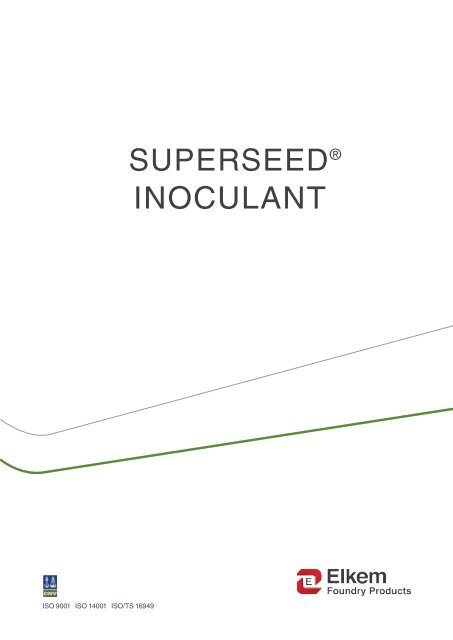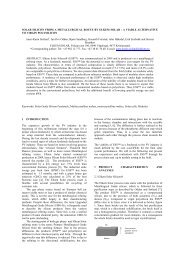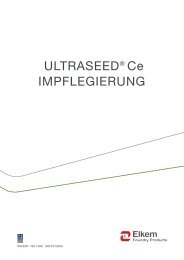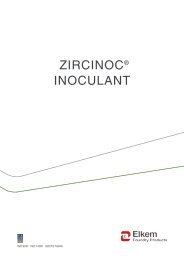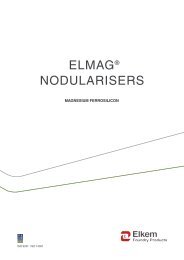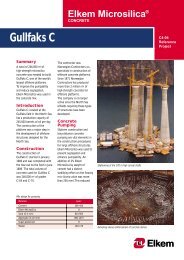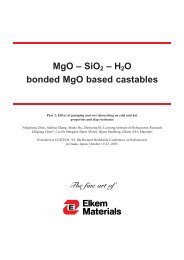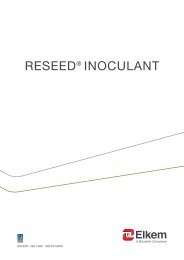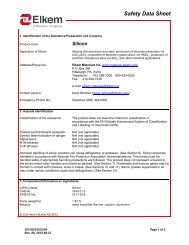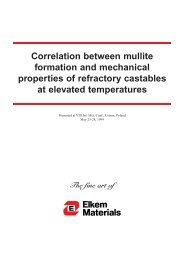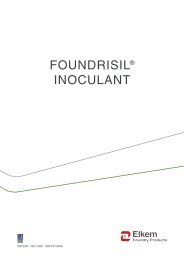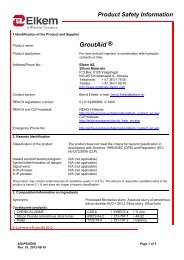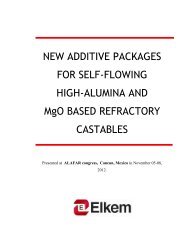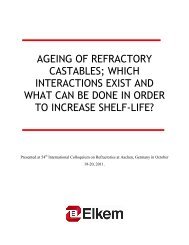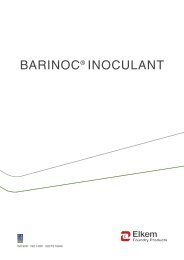SUPERSEED® INOCULANT - Elkem
SUPERSEED® INOCULANT - Elkem
SUPERSEED® INOCULANT - Elkem
Create successful ePaper yourself
Turn your PDF publications into a flip-book with our unique Google optimized e-Paper software.
SUPERSEED ®<br />
<strong>INOCULANT</strong><br />
ISO 9001 ISO 14001 ISO/TS 16949
SUPERSEED ® <strong>INOCULANT</strong><br />
• Gives maximum chill reduction in grey iron<br />
• Extremely effective inoculant for high purity ductile iron<br />
• Promotes less shrinkage than other inoculants<br />
• Low reactive element content gives less dross<br />
• Very low aluminium content minimises risk of promoting hydrogen pinholes<br />
• Cost effective due to small additions<br />
Superseed ® inoculant is a specially formulated<br />
grade of ferrosilicon, which<br />
has become recognised throughout the<br />
world as the most effective inoculant for<br />
the elimination of eutectic carbide or<br />
‘CHILL’ in grey iron. Superseed ® inoculant’s<br />
powerful action is obtained<br />
through the presence of small amounts<br />
of strontium in its composition. Unlike<br />
most other ferrosilicon inoculants it does<br />
not require the presence of aluminium<br />
and calcium to develop its full effect. In<br />
fact small amounts of aluminium, and<br />
particularly calcium, seriously reduce<br />
the nucleation efficiency of Superseed ®<br />
inoculant and are therefore kept at very<br />
low levels during its manufacture.<br />
Superseed ® 75 inoculant is a 75% Si<br />
based ferroalloy produced by a special<br />
process at the <strong>Elkem</strong> Bremanger plant<br />
in Norway, which is ISO 9001, ISO<br />
14001 and ISO/TS16949 certified.<br />
Superseed ® 50 inoculant is a 50% Si<br />
based ferroalloy produced at the <strong>Elkem</strong><br />
Chicoutimi plant in Canada, which has<br />
ISO 9001 and ISO 14001<br />
accreditations.<br />
Superseed ® inoculants are produced to<br />
the following chemical specifications:<br />
Superseed ® 75 Superseed ® 50<br />
Silicon 73 – 78% 46 – 50%<br />
Strontium 0.6 – 1.0%*<br />
Calcium Max 0.10%<br />
Aluminium Max 0.50%<br />
Iron<br />
Balance<br />
*MSI grades 0.8 – 1.4% Sr<br />
The Origin of Superseed ® Inoculant<br />
Superseed ® inoculant is a classic<br />
example of fundamental research by<br />
an independent organisation and<br />
development by an experienced<br />
manu facturer into a major product<br />
with worldwide sales.<br />
The original work, carried out by BCIRA<br />
in England, showed that the presence<br />
of a small amount of strontium in an<br />
otherwise high purity ferrosilicon alloy<br />
produced an inoculant which was far<br />
more effective for the elimination of chill<br />
in cast iron than any other inoculant.<br />
It also showed that traces of calcium<br />
and, to a lesser extent, aluminium,<br />
markedly reduced the inoculating<br />
efficiency of the strontium alloy.<br />
Figure 1 illustrates the superior chill<br />
suppression produced by the strontium<br />
ferro silicon compared with foundry<br />
grade ferrosilicon in 3 mm thick plates<br />
at a 0.25% addition level.<br />
Extensive tests at other independent<br />
laboratories and in iron foundries<br />
throughout the world confirmed the<br />
original results at all typical inoculant<br />
addition levels. The strontium ferrosilicon<br />
alloy, soon to become known as<br />
Superseed ® inoculant, was more effective<br />
than other inoculants in eliminating<br />
chill in thin sections and at corners<br />
and edges of castings, thus avoiding<br />
the risk of expensive tool breakage<br />
during high speed machining.<br />
Figure 1: Superior chill suppression<br />
by Superseed ® inoculant compared<br />
with foundry grade 75% ferrosilicon.<br />
Superseed ® is a registered trademark of <strong>Elkem</strong> AS.
Chill measurements on test pieces from<br />
almost 150 ladles of grey iron at the<br />
<strong>Elkem</strong> R&D lab in USA showed that<br />
Superseed ® inoculant was more effective<br />
in reducing chill than foundry grade<br />
ferrosilicon (FG FeSi) or a proprietary<br />
barium/calcium inoculant at all levels of<br />
addition and that, at heavier additions<br />
of Superseed ® inoculant, the chill could<br />
be reduced to much lower levels than<br />
is possible with the other in oculants.<br />
This is illustra ted in Figure 2. These<br />
tests also indicate that, when changing<br />
from FG FeSi to Superseed ® inoculant,<br />
about half as much Superseed ® inoculant<br />
is required to give a similar level of<br />
chill control thus off setting the additional<br />
cost of the Superseed ® inoculant.<br />
Figure 2: Chill reduction from various<br />
inoculants in grey iron with 3.3% C,<br />
2.0% Si, and 0.08% S.<br />
Unique Features of Superseed ® Inoculant<br />
Superseed ® inoculant differs from other<br />
ferrosilicon inoculants in that it requires<br />
a very small amount of only one reactive<br />
element to obtain its full inoculating<br />
effect. This low total reactive element<br />
content of Superseed ® inoculant imparts<br />
several valuable features, some<br />
of which are unique.<br />
Low Dross – Free and Ready Solution<br />
When an inoculant is added to molten<br />
cast iron a small amount of dross forms,<br />
most of which originates from oxidation<br />
of the reactive elements in the alloy.<br />
The low content of reactive elements<br />
in the Superseed ® inoculant creates<br />
less dross, giving cleaner ladles and<br />
reducing the risk of defects occurring<br />
in the castings. The almost complete<br />
absence of dross also allows Superseed<br />
® inoculant to dissolve readily at<br />
relatively low temperatures down to<br />
1300 °C.<br />
Reduces risk of Pinhole Formation<br />
Hydrogen pinhole defects can occur<br />
when a trace of aluminium is present<br />
in the iron and levels as low as 0.004%<br />
Al can cause pinholes in critical castings.<br />
Most ferrosilicon inoculants have<br />
aluminium contents sufficient to give<br />
almost twice this level at normal ladle<br />
addition rates. The very low aluminium<br />
content of Superseed ® inoculant and<br />
the smaller additions required, yield<br />
only the smallest trace of aluminium,<br />
thus minimising any risk of hydrogen<br />
pinhole formation provided no aluminium<br />
arises from any other source.<br />
Fewer Eutectic Cells for the same<br />
level of Chill Control.<br />
Chill occurs when insufficient nuclei are<br />
present in the iron to prevent it from<br />
undercooling below the ‘metastable’<br />
or ‘white’ eutectic temperature during<br />
solidification. Inoculants reduce undercooling<br />
by creating sufficient nuclei<br />
and thereby prevent chill.<br />
Most inoculants contain aluminium and<br />
one or more other elements that are<br />
instrumental in creating the increased<br />
level of nucleation. However, a trace<br />
of aluminium in the iron can also be<br />
counter-productive in that it will encourage<br />
the iron to pick up hydrogen which<br />
is a very powerful element for promoting<br />
undercooling and chill formation. Most<br />
inoculants therefore need to create<br />
large numbers of nuclei, and hence<br />
eutectic cells, in order to counteract<br />
this additional tendency to undercool.<br />
Figure 3: Polished sections of 5 mm<br />
chill test plates illustrating how, for a<br />
given chill reduction, the use of Superseed<br />
ino culant reduces the formation<br />
of eutectic cells.<br />
Because Superseed ® inoculant is<br />
almost free from aluminium it has no<br />
adverse effect due to increased hydrogen<br />
content and therefore less nuclei<br />
need to grow into eutectic cells to give<br />
the same reduction in undercooling and<br />
chill formation, as illustrated in Figure 3.<br />
This imparts two unique advantages<br />
to Superseed ® inoculant:<br />
1. Less shrinkage<br />
Irons with high eutectic cell numbers<br />
have a marked tendency to form shrinkage<br />
porosity and this often occurs as<br />
a result of inoculation. Because irons<br />
inoculated with Superseed ® inoculant<br />
to the same chill level have lower<br />
eutectic cell numbers, there is less<br />
tendency for shrinkage to occur in these<br />
irons. This is illustrated in Figure 4<br />
which shows two plate-with-boss test<br />
castings inoculated with Superseed ®<br />
inoculant and FG FeSi to the same<br />
chill level.<br />
Figure 4: Section of plate-with-boss<br />
shrinkage test castings – inoculated<br />
with different inoculants to give the<br />
same chilling tendency.
2. Less fading<br />
The increase in eutectic cell numbers<br />
created by inoculation may be regarded<br />
as a supersaturated condition which<br />
fades rapidly with time. Inoculants<br />
giving very high eutectic cell numbers<br />
will fade more rapidly and it is therefore<br />
necessary to cast the metal within<br />
a very short time after inoculation in<br />
order to gain the full benefit of the<br />
addition. Because Superseed ® inoculant<br />
gives a lower eutectic cell number<br />
for the same degree of chill control,<br />
fading is slower and the properties of<br />
the treated iron remain more constant<br />
over a longer period of time. This is illustrated<br />
diagrammatically in Figure 5.<br />
Limitations of Superseed® inoculant<br />
Superseed ® 75 and Superseed ® 50<br />
inoculants are very effective in grey<br />
iron with base sulphur content above<br />
about 0.05%. At or below this level,<br />
other <strong>Elkem</strong> inoculants may be more<br />
effective.<br />
Figure 5: Fading characteristics of<br />
Superseed ® inoculant and FG FeSi.<br />
Superseed ® Inoculant in Ductile Iron<br />
Superseed ® inoculant is extremely<br />
effective for the inoculation of high<br />
purity ferritic ductile iron not requiring<br />
cerium to give good graphite nodularity.<br />
Eutectic carbide is eliminated<br />
from thin sections and the very high<br />
nodule numbers pro duced promote<br />
the formation of fully ferritic structures<br />
as-cast, thus reducing the need for heat<br />
treatment. Many foundries also find<br />
Superseed ® inoculant to be effective<br />
in less pure ductile irons requiring a<br />
small addition of cerium, although<br />
there is some evidence to suggest that<br />
excess cerium reduce the effec tive -<br />
ness of Superseed ® inoculant. In these<br />
circumstances it is recommended that<br />
an alternative inoculant from the <strong>Elkem</strong><br />
range is used.<br />
Application of Superseed ® Inoculant<br />
<strong>Elkem</strong> supply the different ladle<br />
and metal stream inoculation (MSI)<br />
gradings of Superseed ® inoculant<br />
upon customer request and with<br />
certified analysis.<br />
As to ladle inoculation, most foundries<br />
find the amounts of Superseed ®<br />
inoculant required to give adequate<br />
chill control lie between one-half and<br />
two-thirds of other inoculants. The<br />
alloy should be added to the tapping<br />
stream as the ladle is filled or, preferably,<br />
as the metal is transferred from<br />
a supply ladle to the casting ladles.<br />
Superseed ® inoculant should NOT<br />
be dumped into the bottom of a ladle<br />
before filling starts.<br />
With metal stream inoculation, the<br />
power ful inoculating action and the<br />
clean solution characteristics of<br />
Superseed ® inoculant are ideally<br />
suited to this method of inoculation<br />
that is increasing in use in many larger<br />
mass production foundries. Addition<br />
rates are usually 0.1% or less for grey<br />
iron and around 0.15% for ductile iron.<br />
This allows the silicon content of the<br />
base irons to be increased significantly<br />
with the associated advantages of<br />
better scrap utilisation and reduced<br />
lining wear in coreless induction<br />
furnaces.<br />
<strong>Elkem</strong> AS<br />
Foundry Products<br />
Hoffsveien 65B<br />
P.O. Box 5211<br />
Majorstuen<br />
N-0303, Oslo, Norway<br />
Telephone : +47 22 45 01 00<br />
Telefax : +47 22 45 01 52<br />
www.foundry.elkem.com<br />
Revised April 2012 © Copyright <strong>Elkem</strong> AS


